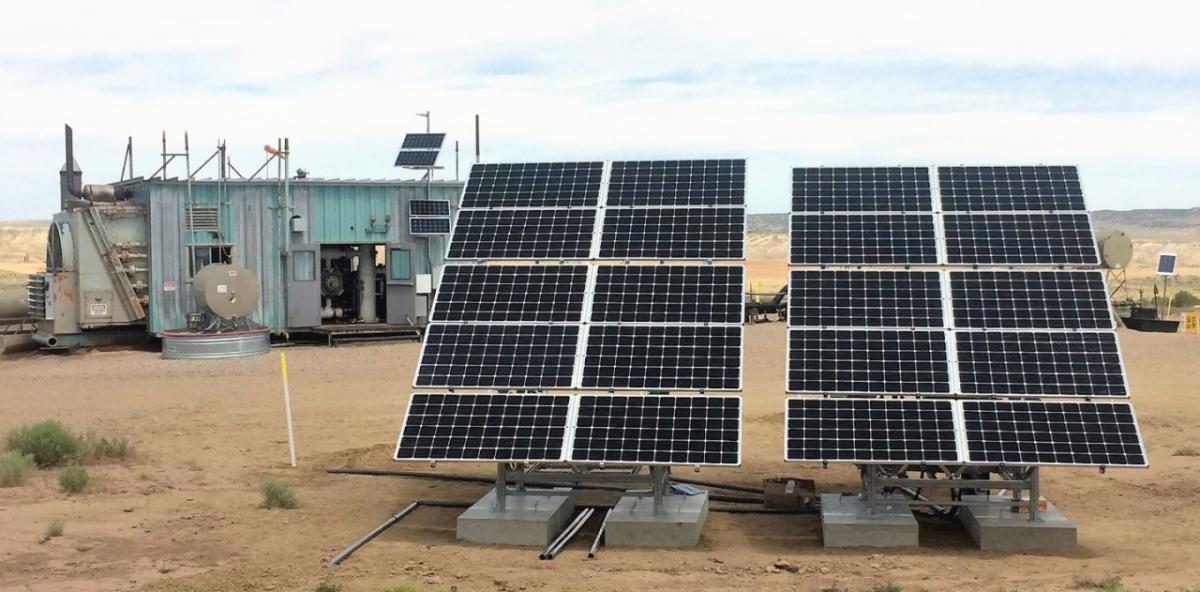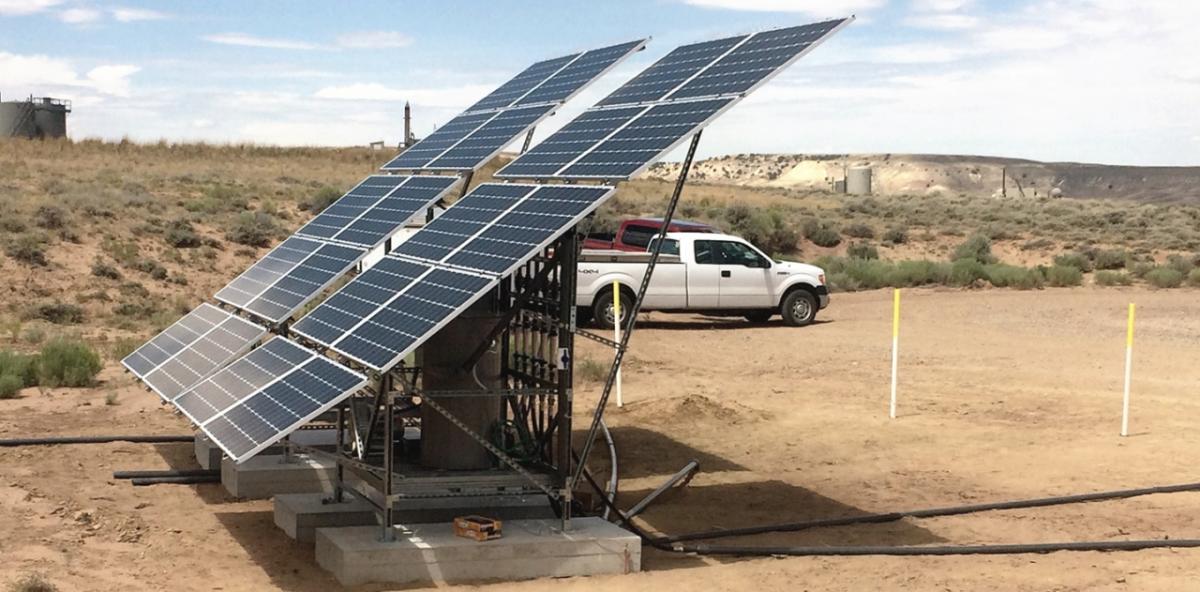Solar Soil Vapor Extraction: Remediation from a Sustainable Angle
WSP USA implemented a solar-powered soil contamination cleaning system for rural oil and gas facilities that is revolutionizing approaches to standard remediation practices.
When contaminated soil is identified for removal from remote locations, traditional dig-and-haul remediation techniques can create logistical and costly difficulties for these off-the-grid sites, not to mention a variety of associated environmental impacts.
This challenge for the oil and gas industry inspired a non-traditional technique developed by WSP USA, that is emerging as a practical, environmentally beneficial alternative to dig-and-haul operations.
The innovative process is known as solar-powered soil vapor extraction (SVE). It was designed for small-scale cleanups at a former northwestern Colorado natural gas compressor station where power infrastructure limitations made dig and haul an impractical option.
“Dig and haul has always been the selected remedy for these types of sites,” said Rob Rebel, senior engineer for WSP. “However, these rural oil and gas facility locations did not allow for the deployment of traditional remediation equipment.”
The natural gas compressor station was investigated and identified to contain more than 3,000 cubic yards of soil, some as much as 35 feet below the surface. The closest landfill was more than 60 miles away.
The long hauling distance would require significant fuel consumption and the large amount of soil transported would significantly reduce the capacity of the landfill where it would be disposed. The economic and environmental impact of this option would be substantial.
The solar SVE system reduces or eliminates many of the negative elements associated with typical dig-and-haul operations: increased truck traffic that can pose safety hazards and degrade roads, nuisance dust and odor, greenhouse gas emissions, increased landfill waste, and higher cost.
Known as the VariSun Mobile Solar System, developed by Sustainable Technologies in Alameda, California, the innovative system not only addressed the power problem for the remote location, but eliminated the need to haul contaminated soil from the site and resulted in no loss of topsoil. The change resulted in a savings of about $50,000.
WSP provided design, operation and maintenance, installation, assessment, reporting, with closure expected in 2021 for the northwestern Colorado oil and gas remediation project.
From Small to Large
Prior to implementing solar, WSP developed trailers that were powered by onsite natural gas. This filled the niche of powering our equipment without the need for a power drop, but was still not viable for some remote sites. It would also not be a transferrable technology for remediation at other locations where wellhead natural gas was unavailable.
So, Rebel and his team designed and built a small-scale SVE unit – under one horsepower – capable of cleaning soil in an inexpensive and sustainable way.
“We deployed two of these systems in locations where power drops were not available,” he said. “Without a power drop and an innovative way to provide power to equipment, dig and haul was the only available technology to clean up some of these remote oil and gas locations.”
Once the system was proven effective, other client interest emerged, but not all were suitable for the smaller system. When larger scale sites were encountered, the firm reached out to Sustainable Technologies, who were building more powerful SVE systems with three-phase motors in the 5-to-20 horsepower range. These are also able to operate off-grid and are direct drive from the solar panels to the motor.
“Four original systems are currently in operation and being used to provide clean-up at remote locations while being cost effective with a minimal environmental footprint,” Rebel said.
Encouraging Change
One challenge in convincing clients to change their approach to remediation was the time involved with completing the task.
“The initial push back we experienced from the clients or regulatory agencies when we presented the idea was concern about the timeframe for remediation of one-to-five years,” Rebel said. “But with land use likely not changing in that timeframe, it has fortunately been an easy hurdle to overcome once other metrics are presented.”
He added that client resistance to the solar-powered SVE approach is further reduced once applicability is proven and the economic benefit is illustrated.
“The regulatory community can be a little more resistant, but once sustainability metrics are brought to the table comparing the remedial options, the regulatory agencies are supportive of efforts that reduce road degradation, dust and odor, and the overall greenhouse gas footprint.”
So far, results have consistently met or exceeded client expectations. With its growth as a viable and practical remediation practice, WSP has expanded its capabilities with the purchase of additional pieces of remediation equipment. One client has sourced a second solar SVE that is currently in use.
A presentation at the AEHS conference in March 2019 highlighted the successes of the SVE application at the Colorado site, and was further explored during a sustainable remediation forum (SURF) case study and a SURF webinar held this past March.
“We will continue to evaluate sites based on sustainability and encourage expanded use of this solar powered system, not just for the ability to work in remote areas where power is not available, but also for its reduced environmental footprint,” Rebel said.
People, Planet, Profit
When addressing a remediation project, Rebel said his team evaluates how the clean-up could impact local communities, the local and global environment, and the client’s bottom line. With different motivations by different stakeholders, he said it is critical to reach common ground and present sustainability metrics that everyone can understand.
“Once exposure is eliminated, instead of just evaluating technologies based on feasibility, we need to expand the evaluation to include overall sustainability – people, planet and profit,” he said. “When finding the balance of these three areas, we will arrive at the best path forward that limits our environmental footprint while allowing communities and businesses to thrive.”
Rebel said he pursued environmental remediation to reduce negative environmental and social impacts that are a by-product of an industrialized society, but five years ago began to realize the process of cleaning up impacted sites sometimes brings with it other environmental problems. “There were times it was going to cost large sums of money for little positive change, or where little to no risk was present.”
This led to his commitment to one of the objectives identified by SURF – “Cleanup contamination without creating more pollution in the process.”
“The paradigm on how to approach site clean-up is changing,” Rebel said. “Still, foremost in any contamination scenario is to ensure lack of exposure to chemicals that negatively affect environmental or human health. It is why we do what we do to ensure the safety of our communities and our land, but now we have the opportunity do it in a more sustainable way.”
[To subscribe to Insights, contact the editorial staff at insights@wsp.com.]



